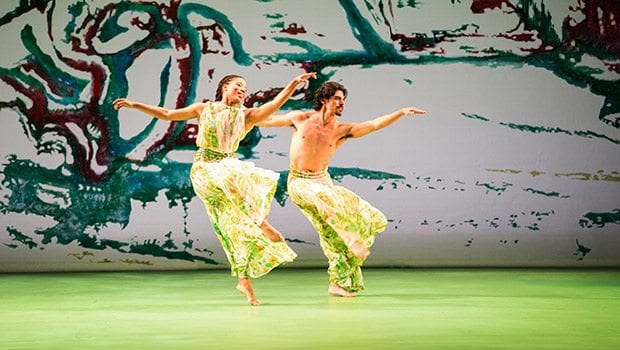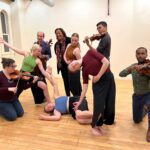‘Acis & Galatea’ invokes ancient myth with powerful East Coast premiere

The spirit of spring animates the latest production of world-renowned choreographer Mark Morris, “Acis & Galatea.” Mingling the arts of opera and dance, the new work had its East Coast premiere last week at Citi Performing Arts Center’s Schubert Theater, presented by the Celebrity Series of Boston, which co-commissioned the work.
Performing on stage were the 18-member Mark Morris Dance Group and four soloists singing the opera’s lead roles. Accompanying them in the orchestra pit were the 32 musicians and 18 singers of Boston’s Handel and Haydn Society Period Orchestra and Chorus, conducted by Nicholas McGegan.
With clarity and simplicity, the production mines the timeless humanity of an ancient myth. The shepherd Acis loves Galatea, a river nymph, and she loves him. The monster Polyphemus also loves her, but she spurns him. In a jealous rage, he hurls a boulder at Acis and kills him. Galatea then summons her magical powers and transforms Acis into a stream that will flow forever.
With his long-time collaborators McGegan, scenic designer Adrianne Lobel, fashion designer Isaac Mizrahi, and lighting designer Michael Chybowski, Morris injects fresh contemporary spirit to Handel’s 1718 operatic version of the tale and its 1788 arrangement by Mozart, who added clarinet, bassoon and horn.
Opera is a natural for Morris, the most musical of choreographers. As a director and choreographer, Morris mingles the irreverent with the sublime in inventive dancing that draws from natural, everyday movement — walks, leaps, runs, folk dance, even gym workouts — as well as modern and ballet traditions. He also has a knack for sly casting.
As the lovers, tenor Thomas Cooley (Acis) and soprano Sherezade Panthaki (Galatea) have marvelous voices but an unglamorous stage presence accented by workaday costumes — a short dress for Panthaki and Cooley’s loose shirt and pants. Morris is making it plain that the transporting experiences of love and art are the business of ordinary human beings.
Surrounding these two and intertwining them in their circles are the dancers, as sleek and graceful as can be. While the lovers wear sturdy cotton clothing, the dancers wear gossamer fabric. Males and females alike wear diaphanous long skirts in a green camouflage print that echoes the set — a prop-free series of layered screens with brush-stroked images of woods and a rocky hillside reminiscent of Asian woodblock prints. Lit by Chybowski, they evoke a dappled forest.
As an opera, all the words are sung, not spoken, and the 1718 libretto by English poets John Gay, Alexander Pope and John Hughes was displayed as supertitles.
The dancers’ movements often paint the words, and with music, chorus, sets, costumes and lighting in synch, the production ignites a thrilling mix of senses. The frequent repetition of passages in the music, words and choreography as they unfold in unison heightens the emotional intensity.
In the first act, the dancers swirl in a delirium of joy, pushing and pulling each other in pairs and clusters and winding and unraveling with astonishing fluidity and precision.
The singers’ movements are choreographed too. Galatea, burning with love, blocks her ears as if to resist the charms of the chorus who sing of “happy nymphs and happy swains.” Later, when Acis dies, she turns her back to the audience, bereft, a lone figure on a darkened stage.
The second act opens with a long, lovely musical prelude. Its shadows set the tone for loss to come. The dancers move in slow, repetitive knots that build in pauses, like the syncopated blue notes in a jazz composition.
Polyphemus gains an introduction befitting a formidable creature. As the chorus sings of his “ample strides,” a light-as-air pyramid of dancers bounces across the stage in the shape of giant footsteps. As the singers describe how “the forest shakes” with his “giant roars,” the dancers’ arms and legs quiver and their bodies tumble like wind-felled trees. Enter baritone Douglas Williams, whose monster is a wiry, suave dandy sporting a natty suit in the same camouflage fabric worn by the other singers. Williams brings to his role the gleeful panache of a Broadway leading man. He subjects the dancers to slaps, strokes, pinches, gropes and other lewd gestures as they file past him, shoulders slumped in submission, and collapse in a pile behind him.
Entreating Polyphemus to not force himself on Galatea, tenor Zach Finkelstein, as Damon, a friend of Acis, leads the chorus in a soft refrain, “Softly, gently, kindly treat her.” Meanwhile, brooding in ominous isolation, Polyphemus is on the floor stretching himself. All that is visible are his languorously flexing feet.
Signaling the gathering doom, Laurel Lunch performs a chilling solo, marching while holding her head, face and shoulders rigid.
With a flick of his arm, Polyphemus triggers the fatal blow. The boulder takes the form of delicate Maile Okamura, whose partners, standing in a row, jettison her over their heads across the width of the stage to strike Acis.
Urged on by the chorus, Galatea transforms her dead lover into a kindred immortal. He reappears with a wreath on his head and a shawl on his shoulders, before becoming immersed by an undulating stream of dancers.
Draped in a scarf like the reborn Acis, Morris joins the performers on stage and leads them in a succession of decorous, balletic bows.

![Banner [Virtual] Art Gallery](https://baystatebanner.com/wp-content/uploads/2024/04/NJ-H_1-150x150.jpg)


![Banner [Virtual] Art Gallery](https://baystatebanner.com/wp-content/uploads/2024/04/NJ-H_1-713x848.jpg)

